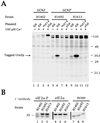Internal initiation in Saccharomyces cerevisiae mediated by an initiator tRNA/eIF2-independent internal ribosome entry site element
- PMID: 11687653
- PMCID: PMC60809
- DOI: 10.1073/pnas.241286698
Internal initiation in Saccharomyces cerevisiae mediated by an initiator tRNA/eIF2-independent internal ribosome entry site element
Abstract
Internal initiation of translation can be mediated by specific internal ribosome entry site (IRES) elements that are located in certain mammalian and viral mRNA molecules. Thus far, these mammalian cellular and viral IRES elements have not been shown to function in the yeast Saccharomyces cerevisiae. We report here that a recently discovered IRES located in the genome of cricket paralysis virus can direct the efficient translation of a second URA3 cistron in dicistronic mRNAs in S. cerevisiae, thereby conferring uracil-independent growth. Curiously, the IRES functions poorly in wild-type yeast but functions efficiently either in the presence of constitutive expression of the eIF2 kinase GCN2 or in cells that have two initiator tRNA(met) genes disrupted. Both of these conditions have been shown to lower the amounts of ternary eIF2-GTP/initiator tRNA(met) complexes. Furthermore, tRNA(met)-independent initiation was also observed in translation-competent extracts prepared from S. cerevisiae in the presence of edeine, a compound that has been shown to interfere with start codon recognition by ribosomal subunits carrying ternary complexes. Therefore, the cricket paralysis virus IRES is likely to recruit ribosomes by internal initiation in S. cerevisiae in the absence of eIF2 and initiator tRNA(met), by the same mechanism of factor-independent ribosome recruitment used in mammalian cells. These findings will allow the use of yeast genetics to determine the mechanism of internal ribosome entry.
Figures






Comment in
-
Unleashing yeast genetics on a factor-independent mechanism of internal translation initiation.Proc Natl Acad Sci U S A. 2001 Nov 6;98(23):12866-8. doi: 10.1073/pnas.241517998. Proc Natl Acad Sci U S A. 2001. PMID: 11698676 Free PMC article. No abstract available.
Similar articles
-
Yeast initiator tRNA identity elements cooperate to influence multiple steps of translation initiation.RNA. 2006 May;12(5):751-64. doi: 10.1261/rna.2263906. Epub 2006 Mar 24. RNA. 2006. PMID: 16565414 Free PMC article.
-
Initiation factor-independent translation mediated by the hepatitis C virus internal ribosome entry site.RNA. 2006 May;12(5):894-902. doi: 10.1261/rna.2342306. Epub 2006 Mar 23. RNA. 2006. PMID: 16556939 Free PMC article.
-
The A1 x U72 base pair conserved in eukaryotic initiator tRNAs is important specifically for binding to the eukaryotic translation initiation factor eIF2.Mol Cell Biol. 1996 Aug;16(8):4248-56. doi: 10.1128/MCB.16.8.4248. Mol Cell Biol. 1996. PMID: 8754825 Free PMC article.
-
Translation initiation by factor-independent binding of eukaryotic ribosomes to internal ribosomal entry sites.C R Biol. 2005 Jul;328(7):589-605. doi: 10.1016/j.crvi.2005.02.004. C R Biol. 2005. PMID: 15992743 Review.
-
Regulation of translation initiation by amino acids in eukaryotic cells.Prog Mol Subcell Biol. 2001;26:155-84. doi: 10.1007/978-3-642-56688-2_6. Prog Mol Subcell Biol. 2001. PMID: 11575165 Review.
Cited by
-
ISG20: an enigmatic antiviral RNase targeting multiple viruses.FEBS Open Bio. 2022 Jun;12(6):1096-1111. doi: 10.1002/2211-5463.13382. Epub 2022 Feb 27. FEBS Open Bio. 2022. PMID: 35174977 Free PMC article. Review.
-
Initiation of translation on nedicistrovirus and related intergenic region IRESs by their factor-independent binding to the P site of 80S ribosomes.RNA. 2023 Jul;29(7):1051-1068. doi: 10.1261/rna.079599.123. Epub 2023 Apr 11. RNA. 2023. PMID: 37041031 Free PMC article.
-
Initiation of translation by cricket paralysis virus IRES requires its translocation in the ribosome.Cell. 2014 May 8;157(4):823-31. doi: 10.1016/j.cell.2014.04.015. Epub 2014 May 1. Cell. 2014. PMID: 24792965 Free PMC article.
-
Structural elements in the internal ribosome entry site of Plautia stali intestine virus responsible for binding with ribosomes.Nucleic Acids Res. 2003 May 1;31(9):2434-42. doi: 10.1093/nar/gkg336. Nucleic Acids Res. 2003. PMID: 12711689 Free PMC article.
-
Initiation of protein synthesis by hepatitis C virus is refractory to reduced eIF2.GTP.Met-tRNA(i)(Met) ternary complex availability.Mol Biol Cell. 2006 Nov;17(11):4632-44. doi: 10.1091/mbc.e06-06-0478. Epub 2006 Aug 23. Mol Biol Cell. 2006. PMID: 16928960 Free PMC article.
References
-
- Donahue T F. In: Translational Control of Gene Expression. Sonenberg N, Hershey J W B, Mathews M B, editors. Plainview, NY: Cold Spring Harbor Lab. Press; 2000. pp. 487–502.
-
- Evstafieva A G, Beletsky A V, Borovjagin A V, Bogdanov A A. FEBS Lett. 1993;335:273–276. - PubMed
-
- Das S, Ott M, Yamane A, Venkatesan A, Gupta S, Dasgupta A. Front Biosci. 1998;3:D1241–D1252. - PubMed
Publication types
MeSH terms
Substances
Grants and funding
LinkOut - more resources
Full Text Sources
Other Literature Sources
Molecular Biology Databases
Miscellaneous

